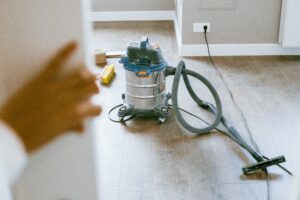Post-construction cleaning requires specialized equipment and systematic approaches to restore Alexandria homes to pristine condition. Professional services utilize industrial-grade HEPA vacuums, heavy-duty cleaning supplies, and proper PPE for thorough debris removal. The process involves methodical top-to-bottom cleaning, attention to ventilation systems, and eco-friendly solutions for various surfaces. While DIY cleaning presents risks, professional services guarantee comprehensive restoration with long-term value. The following sections detail essential strategies for peak post-renovation results.
Key Takeaways
- Hire professional cleaning services equipped with industrial-grade HEPA vacuums and specialized tools to ensure thorough post-construction debris removal.
- Start cleaning from ceiling to floor, addressing hidden areas like ventilation systems and behind appliances to prevent dust redistribution.
- Use appropriate PPE including masks, gloves, and safety goggles while handling post-construction cleanup to protect against harmful particles.
- Apply eco-friendly cleaning solutions to effectively remove construction residue while maintaining Alexandria’s environmental standards.
- Implement systematic cleaning protocols focusing on problem areas like windows, bathroom fixtures, and light fixtures for complete restoration.
Essential Post-Construction Cleaning Equipment and Supplies
A well-equipped cleaning arsenal forms the foundation of successful post-construction cleanup operations. The cornerstone of essential post-construction cleaning equipment includes industrial-grade vacuum cleaners specifically engineered to handle heavy debris and fine particles that standard vacuums cannot manage.
Professional cleaning teams utilize heavy-duty mops, microfiber cloths, and floor scrubbers to efficiently restore surfaces to their intended condition. Personal protective equipment plays a critical role in maintaining worker safety, with masks, gloves, and safety goggles protecting staff from construction dust and potentially harmful materials. The cleaning process requires specialized solutions, including degreasers and environmentally conscious cleaning products, to effectively remove construction residue. This comprehensive equipment selection guarantees thorough cleaning while safeguarding both the cleaning staff and the newly renovated spaces.
Step-by-Step Guide to Deep Cleaning After Renovations
The post-renovation cleaning process begins with a thorough dust removal phase, which requires systematic top-to-bottom cleaning to prevent recontamination of cleaned areas. Surface sanitization follows, incorporating industrial-grade cleaning agents and equipment to address all horizontal and vertical surfaces, ensuring the removal of construction residue and potential contaminants. A meticulous final inspection validates the cleaning effectiveness by examining corners, edges, and frequently overlooked spaces while confirming that all areas meet cleanliness standards for safe occupancy.
Initial Dust Removal Process
Starting post-construction cleaning with proper dust removal prevents lingering particles from settling throughout the home and compromising indoor air quality. The initial dust removal process begins with a HEPA vacuum to capture fine particles from floors, walls, and surfaces, ensuring a thorough clean. Following systematic cleaning from top to bottom maximizes efficiency and prevents recontamination of cleaned areas.
| Surface Type | Tool Required | Method |
|---|---|---|
| Ceilings & Fixtures | Microfiber Cloth | Wipe down carefully |
| Walls & Counters | Damp Cloth | Clean in sections |
| Floors & Baseboards | HEPA Vacuum/Mop | Vacuum then damp mop |
Completing the process requires attention to detail, including wiping down all surfaces with appropriate cleaning tools and conducting a final inspection using lint rollers or tape to capture any remaining particles on upholstery or curtains.
Sanitize All Surface Areas
Sanitizing surface areas after construction requires a systematic, multi-step approach to guarantee complete removal of contaminants and restoration of a healthy living environment.
Begin the sanitization process by employing a HEPA-filtered vacuum to eliminate loose dust and debris from all surfaces. Follow with a thorough wipe-down using damp microfiber cloths on countertops, cabinets, and baseboards to trap remaining particles. For glass surfaces and mirrors, apply a specialized glass cleaner or vinegar solution to achieve streak-free results. High-touch areas demand particular attention – doorknobs, light switches, and faucets require targeted disinfection with appropriate cleaning agents. Complete the sanitization process with comprehensive floor treatment, incorporating sweeping, vacuuming, and mopping techniques to ensure all construction residue is effectively removed, creating a clean, safe living space.
Final Detail Inspection Steps
When conducting final detail inspections after construction cleanup, professionals must follow a comprehensive checklist to guarantee no areas are overlooked. The inspection process focuses particularly on high-traffic zones where debris and dust accumulation are most common. Inspectors utilize specialized cleaning tools to verify surfaces meet cleanliness standards and identify any missed spots requiring additional attention.
- Systematic room-by-room assessment, checking corners, baseboards, and ceiling fixtures for remnants of construction debris
- Verification of proper cleaning in hard-to-reach areas, including HVAC vents, light fixtures, and window tracks
- Documentation of completed work and any areas requiring touch-ups, ensuring all surfaces meet quality standards
This final inspection serves as quality assurance, confirming that the space is safe, clean, and ready for occupancy while maintaining professional cleaning standards throughout the project completion.
Professional vs. DIY Post-Construction Cleaning
Professional post-construction cleaning services deploy industrial-grade equipment and specialized tools that surpass typical household cleaning supplies, enabling thorough removal of construction debris and hazardous materials. The initial investment in professional services often yields long-term value through reduced health risks, proper waste disposal, and prevention of property damage that could result from inexperienced DIY efforts. While DIY cleaning may appear cost-effective initially, the combination of specialized equipment requirements, safety considerations, and time investment typically makes professional services the more economical choice for comprehensive post-construction cleaning.

Equipment and Safety Requirements
The stark differences between professional and DIY post-construction cleaning equipment significantly impact the quality and safety of the final results. Commercial cleaning services utilize industrial-grade equipment, including HEPA vacuums and pressure washers, guaranteeing thorough removal of construction debris and hazardous materials. Professional services also maintain strict safety requirements, requiring workers to use proper PPE and follow established protocols for handling potentially dangerous substances.
Key distinctions in equipment and safety measures include:
- Industrial-grade HEPA filtration systems that capture microscopic particles, unlike standard household vacuums
- Specialized cleaning agents and equipment designed specifically for post-construction environments
- Comprehensive PPE kits including respiratory protection, eye protection, and proper protective clothing
These professional-grade tools and safety measures guarantee complete cleaning while protecting both workers and occupants from potential health hazards, making professional services a superior choice for post-construction cleanup.
Cost-Benefit Analysis
Building on the importance of proper equipment and safety measures, a thorough cost-benefit analysis reveals compelling insights into the financial implications of professional versus DIY post-construction cleaning.
While DIY cleaning might appear cost-effective initially, at $0.10 to $0.50 per square foot, professional services often prove more economical when considering long-term value. Professionals who take care of post-construction cleaning in your home or business utilize industrial-grade equipment and environmentally safe products, completing tasks more efficiently than untrained individuals. The cost-benefit analysis extends beyond immediate expenses, factoring in potential property value improvement and reduced future maintenance needs. Professional cleaners’ expertise prevents oversights in hard-to-reach areas, ultimately delivering superior results that justify the investment while minimizing risks associated with improper cleaning methods and hazardous material handling.
Safety Measures During Post-Construction Cleanup
Implementing proper safety measures during post-construction cleanup is critical for protecting workers and future occupants from potential health hazards. Personal protective equipment (PPE) serves as the first line of defense against construction debris and harmful materials. All rights reserved contractors must guarantee their teams follow systematic cleaning protocols, working from ceiling to floor to prevent dust redistribution.
- Industrial-grade cleaning equipment and proper waste segregation protocols protect property value for those looking to sell my personal residence
- Trained personnel must handle hazardous materials according to local regulations
- Final inspections verify the space is dust-free and safe for occupancy
Professional cleanup crews implement these safety measures while maintaining efficiency. They utilize appropriate cleaning products and follow strict disposal guidelines for different waste categories, guaranteeing a thorough and secure post-construction environment that meets health and safety standards.
Common Problem Areas to Address After Construction
Once construction work concludes, several critical areas require immediate attention to guarantee a thorough cleaning process. Ventilation systems and spaces behind appliances often harbor accumulated dust and debris, which must be removed to maintain proper air quality. Special focus should be directed to floors, where construction residue can compromise both carpeted and hardwood surfaces, potentially requiring deep cleaning or refinishing.
Light fixtures and ceiling fans present another challenge, as they collect substantial dust during renovations that can disperse throughout the home when activated. Window cleaning demands particular attention to remove paint smears and construction dust, ensuring peak visibility. Additionally, bathroom fixtures and surfaces need thorough sanitization to eliminate any construction material contamination, creating a safe and hygienic environment for occupants.
Eco-Friendly Cleaning Solutions for Construction Debris
When addressing post-construction cleanup, environmentally conscious solutions offer both effective debris removal and sustainable practices that protect indoor air quality. Professional cleaning services now emphasize certified green products that efficiently break down dust and grime while maintaining strict environmental standards. These eco-friendly approaches significantly reduce VOC levels in newly renovated spaces, creating healthier living environments for occupants.
- Biodegradable cleaning agents effectively remove construction residue without introducing harmful chemicals into the home
- Integrated recycling practices sort and process cardboard, plastic, and metal debris, minimizing waste
- Green-certified cleaning products guarantee thorough debris removal while maintaining superior indoor air quality
Time-Saving Strategies for Efficient Post-Construction Cleanup
Beyond eco-friendly practices, maximizing efficiency in post-construction cleanup requires strategic planning and methodical execution. Professional cleaning services employ systematic approaches by dividing spaces into manageable sections and prioritizing high-traffic areas. Industrial-grade equipment and specialized cleaning products accelerate the removal of construction dust and debris.
| Time-Saving Element | Strategic Benefit |
|---|---|
| Sectional Planning | Prevents overlap and guarantees thorough coverage |
| Professional Tools | Reduces manual labor and increases effectiveness |
| Waste Sorting System | Streamlines disposal and recycling processes |
| Expert Services | Utilizes specialized knowledge and equipment |
A well-structured cleaning plan identifies specific target areas and allocates resources efficiently. This approach, combined with proper waste management strategies, minimizes cleanup duration while maintaining quality standards. Organizations can optimize their post-construction restoration process by implementing these time-saving strategies and employing professional expertise when necessary.
Frequently Asked Questions
How to Get Rid of Post-Renovation Dust?
Like a ghost that refuses to leave, post-renovation dust requires a systematic approach to banish completely. Effective removal starts with HEPA vacuum cleaning to capture fine particles, followed by top-to-bottom surface cleaning using damp microfiber cloths. Proper ventilation through open windows or fans helps dissipate airborne dust. For best results, professional cleaning services equipped with specialized tools can guarantee thorough dust elimination and restore pristine conditions.
How to Deep Clean a House After Renovation?
Deep cleaning a house after renovation requires a systematic approach. Professionals recommend starting with HEPA vacuuming of all surfaces, including walls and ceilings, followed by damp wiping with appropriate cleaning solutions. Air duct cleaning removes construction debris, while specialized equipment addresses hard-to-reach areas. Window tracks, light fixtures, and cabinet interiors need thorough attention. Final sanitization of all surfaces guarantees a properly restored living space.
How Much Does It Cost to Clean a House After Construction?
Post-construction cleaning costs typically range from $0.10 to $0.25 per square foot, with total expenses varying between $300 and $800 for average-sized homes. Larger properties or complex projects may exceed these baseline costs. Additional services like carpet cleaning or upholstery treatment can add $50 to $150 per service. Property location, debris volume, and specialized cleaning requirements influence final pricing. Most companies offer free quotes to provide accurate cost assessments based on specific needs.
Who Is Responsible for Cleanup After Construction?
The primary responsibility for post-construction cleanup typically falls on the contractor, who should remove major debris, construction waste, and materials from the site. However, specific cleanup duties should be clearly outlined in the construction contract. While contractors handle initial cleanup, homeowners may need to hire professional cleaning services for detailed post-construction cleaning. Local regulations may require contractors to manage hazardous material disposal, making it essential to verify compliance during the cleanup process.





